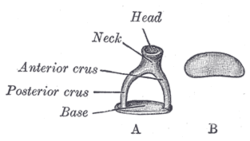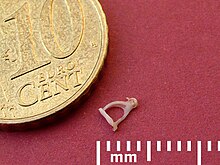Stapes
| Stapes | |
|---|---|
 Frontal view of stapes (A), and view from below (B). | |
| Details | |
| Pronunciation | /ˈsteɪpiːz/ |
| Precursor | second branchial arch |
| Part of | Middle ear |
| System | Auditory system |
| Articulations | Incudostapedial joint |
| Identifiers | |
| Latin | 'stapes' |
| MeSH | D013199 |
| TA98 | A15.3.02.033 |
| TA2 | 895 |
| FMA | 52751 |
| Anatomical terms of bone | |
 |
| This article is one of a series documenting the anatomy of the |
| Human ear |
|---|
The stapes or stirrup is a
Structure

The stapes is the third bone of the three
Development
The stapes develops from the second
Animals
The stapes is one of three ossicles in mammals. In non-mammalian
Variation
The stapes appears to be relatively constant in size in different ethnic groups.[6] In 0.01–0.02% of people, the stapedial artery does not regress, and persists in the central foramen.[7] In this case, a pulsatile sound may be heard in the affected ear, or there may be no symptoms at all.[8] Rarely, the stapes may be completely absent.[9][10]: 262
Function
Situated between the incus and the inner ear, the stapes transmits sound vibrations from the incus to the oval window, a membrane-covered opening to the inner ear. The stapes is also stabilized by the
Clinical relevance
Otosclerosis is a congenital or spontaneous-onset disease characterized by abnormal bone remodeling in the inner ear. Often this causes the stapes to adhere to the oval window, which impedes its ability to conduct sound, and is a cause of conductive hearing loss. Clinical otosclerosis is found in about 1% of people, although it is more common in forms that do not cause noticeable hearing loss. Otosclerosis is more likely in young age groups, and females.[11] Two common treatments are stapedectomy, the surgical removal of the stapes and replacement with an artificial prosthesis, and stapedotomy, the creation of a small hole in the base of the stapes followed by the insertion of an artificial prosthesis into that hole.[12] : 661 Surgery may be complicated by a persistent stapedial artery, fibrosis-related damage to the base of the bone, or obliterative otosclerosis, resulting in obliteration of the base.[7][10] : 254–262
History

The stapes is commonly described as having been discovered by the professor
References
- S2CID 43418740.
- ^ PMID 21196256.
- ^ ISBN 978-0-8089-2306-0.
- PMID 16050903.
- ISBN 978-0-03-910284-5.
- .
- ^ S2CID 25682582.
- PMID 10730654.
- S2CID 33351053.
- ^ ISBN 978-1-282-86537-2.
- PMID 12680829.
- ISBN 978-0-7216-0240-0.
- PMID 24227905.
- S2CID 30466939.
- ^ Harper, Douglas. "Stapes (n.)". Online Etymology Dictionary. Retrieved 27 December 2013.
External links
- "3-D Virtual Models of the Human Temporal Bone and Related Structures". Eaton Peabody Laboratory of Auditory Physiology. Retrieved September 8, 2016.
